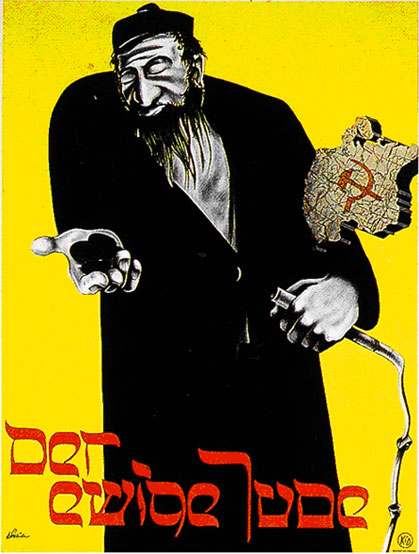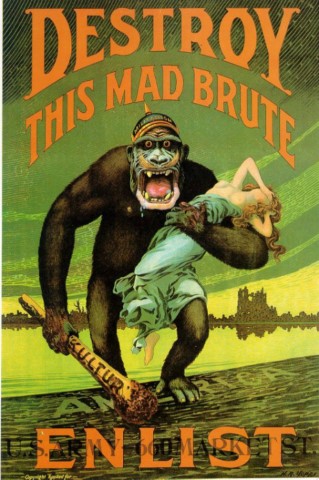Though both sides had extensively
utilised propaganda during World War I and the technique was
likewise to flourish throughout the Soviet system, no one group made
more protracted or effective use of propaganda than the Nazis.

In the two decades preceding their
demise in 1945, Hitler’s National Socialists produced many thousands
of posters, pamphlets, films and books designed to extol the virtues
of the party’s infallible leader or its many constituent factions,
though after Hitler’s ascension to power in 1933 the emphasis
largely shifted to railing against enemies both internal and
external. The two most prominent of these were, of course, Jews and
Bolsheviks, forces seen as essentially one and the same in the dark
recesses of Hitler’s fevered mind; to his final days he would rant
about the alleged crimes perpetrated by ‘international Jewry.’ This
obsession is evident in much surviving Nazi propaganda and spans a
variety of media, from the infamous 1940 film The Eternal Jew,
with its sequences superimposing images of ghetto-dwelling Jews over
those of rats escaping a sewer, to the children’s book The Poison
Mushroom, published by the infamous anti-Semite Julius Streicher
- one of the most chilling photographs in the present book shows a
handful of blond-haired schoolchildren innocently flicking through
this brightly-coloured, picture-filled grotesquery, which equated
Jews to toadstools and warned children how to spot these ‘criminals
and swindlers.’
But it was in the propaganda poster
that the Nazi penchant for artful vitriol found its fullest
expression. Masterpieces of the perverse that were frequently
produced by the leading artists of the period, such posters raged
against the Western Powers, the treaty of Versailles, Jews,
work-shirkers, Socialists, Communists and others, and comprise some
of the most striking, memorable and vitriolic examples of their
kind. Posters also praised the merits of Aryan blood, of youth,
family, land and liberty, in a powerful neo-Pagan style that is at
once potent and cloying.

State of Deception provides an
expert analysis of this shifting Nazi use of propaganda as well as
its role in promoting both community and conformity, and its 196
pages are littered with many hundreds of noteworthy examples, the
majority reproduced in full colour. Of particular interest are the
early chapters detailing British and American propaganda throughout
World War I. Whereas German propaganda had been content to portray
the enemy as ridiculous, its markedly more effective Allied
counterpart painted the Germans as a bloodthirsty horde to be
vanquished at all costs. Stories of bestial German atrocities
abounded, such as a supposed predilection for cutting off the hands
of young Belgian girls – that such stories were entirely untrue was
not important, for they combined effortlessly with posters depicting
the ‘Hun’ as a marauding ape sporting a spiked helmet and club.
Such a mentality pervaded much of the Nazi propaganda effort
directed against Jews and Russians: one of the most ardent admirers
of World War I Allied propaganda was, in fact, Adolf Hitler, then a
frontline soldier, and he evidently learnt his lessons well.
State of Deception is a
monumental work which expertly combines a fascinating historical
narrative with numerous well-chosen photographs, posters, leaflets
and other ephemera of this uniquely tempestuous epoch. It is a
thought-provoking and impeccably presented testament to mankind’s
aptitude for wilful self-deception, not to say debasement, and as
enlightening an encapsulation of the ‘age of propaganda’ as has ever
been attempted.